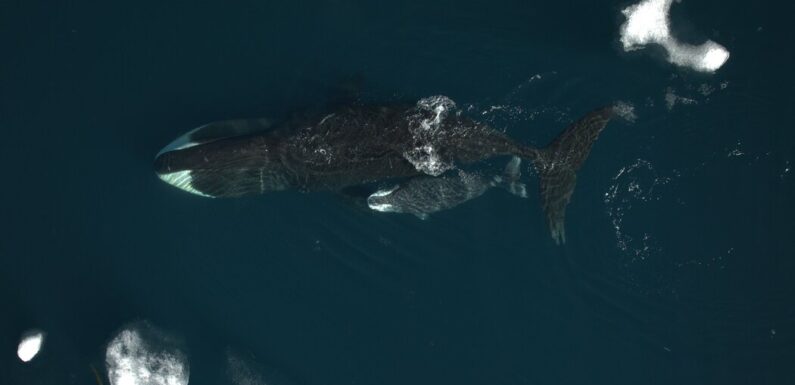
For animals that humans almost drove into extinction, there’s a lot about whales we still don’t know. Consider the bowhead whale in particular.
“Bowhead whales can live greater than 200 years, they go into sexual maturity late and it takes them a long time to grow,” said Nadine Lysiak, a marine biologist who has been studying bowheads and other baleen whales for years. “But even today, we’re still learning very basic things about the reproductive cycle of animals like these. They’re very cryptic, we don’t see most of their life since they spend a fraction of it at the surface.”
Slowly but surely, Dr. Lysiak has been peeling back the layers of aquatic secrecy surrounding these white-chinned travelers of the Arctic Ocean. She and her colleagues may have uncovered a rather extraordinary feat of nature: Females of the species may spend 23 months pregnant before giving birth to a baby bowhead. That would edge out elephant pregnancies — the longest known within the mammalian kingdom — by a month.
Their findings, published on Wednesday in the journal Royal Society Open Science, illuminate the complexities underlying the whale’s population growth, which Dr. Lysiak hopes can guide conservation efforts, especially as an inhospitable climate looms.
To study free-ranging mammals like bowhead whales, scientists have had to rely on field observations and surveys, as well as carcasses washed up on shores. But for this study, Dr. Lysiak and her colleagues looked at samples taken from 10 female bowhead whales collected by Inuit hunters in the eastern Canadian Arctic and West Greenland from 1998 through 2011.
The study relied on the baleen, or the fibrous off-white bristles in the mouths of whales. While tissue samples from blubber or skin provide a snapshot at a single moment in an animal’s life, baleen offers a much wider lens. These teeth-like projections in the whale’s mouth — its filtration system keeping food in and water out — bloom from the gum and retain a molecular record of the body’s circulating hormones.
After gathering tiny samples from each whale’s baleen, the researchers measured the concentrations of three hormones: progesterone, which is produced shortly before and during pregnancy; estradiol, also known as estrogen released in considerable amounts when an animal goes into heat (or estrus); and corticosterone, a biomarker of stress that also plays a role in fetal development.
Analysis of the data returned a pair of surges in progesterone over time that confounded the researchers’ expectation that bowhead pregnancy lasted about 14 months.
“I double and triple checked everything just to make sure I believed in the numbers and the timelines we were using,” Dr. Lysiak said.
An explanation of the data suggested two scenarios. In one, the bowhead whale’s pregnancy lasts 23 months. In the other, the whales weren’t pregnant during the first massive progesterone surge, but were instead experiencing a prolonged state of estrus or ovulating. The second progesterone peak, lasting about 14 months, was when the marine mammal was actually pregnant.
That second scenario aligned with what biologists knew about bowhead whale fetus sizes — small or big in the spring, medium-size in the fall. But Dr. Lysiak said there is a phenomenon that could explain the first scenario: delayed implantation, also known as embryonic diapause.
When a fertilized egg develops into an embryo, there’s a point at which the mother’s body can put the pregnancy on hold. It’s considered a survival advantage that allows the mother’s body to essentially decide when is the right time to have the baby. Depending on the species, this pause can last anywhere from a couple of days to 11 months.
“That’s something that occurs in a lot of marine mammals, like seals, bears, otters, a lot of terrestrial animals but, until now, it’s been discounted as occurring in baleen whales,” Dr. Lysiak said.
While more research is needed to pinpoint whether bowhead pregnancies last 23 months, the findings come at a time when the species is at risk.
“This paper helps us further understand the underlying physiological complexity of these really large, charismatic, but also very ecologically important, species that just so happens is generally hard to study,” said Logan Pallin, a marine biologist at the University of California, Santa Cruz, who wasn’t involved in the study. “It’s work like this that incrementally moves us in the right direction to use science to make better informed decisions on conservation.”
Source: Read Full Article